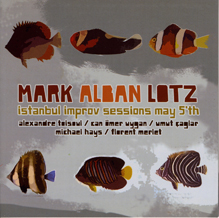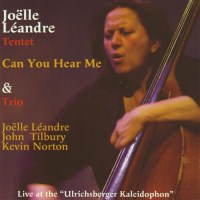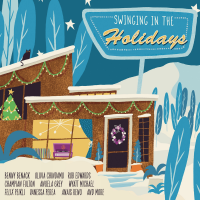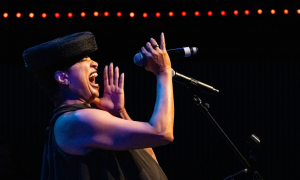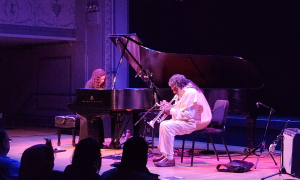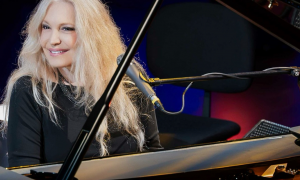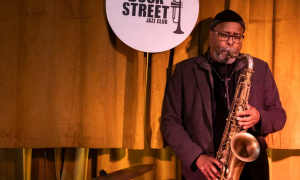Home » Jazz Articles » Live Review » Borneo Jazz 2011
Borneo Jazz 2011

Miri, Sarawak, Borneo
May 12-15, 2011
Borneo Jazz—known as the Miri International Jazz Festival for the previous five editions—has undergone a certain amount of rebranding in an effort to promote its growing stature as one of the leading jazz festivals in the region. This year the festival has increased from two to four days, with the opening night formerly reserved for musicians and media now open to the public. In addition, Borneo Jazz has extended its reach in the city of Miri, by staging Musical Meetings—spontaneous jam sessions—in the Marriott Hotel, and putting on a Sunday matinee concert at the Eastwood Valley Golf Club. These innovations indicate the growing ambition of the organizers to spread the festival in the Miri community. They also show the desire to increase the number of festival goers, with the 2011 edition's stated aim to attract 10,000 people—a large jump compared to last year's 7,000.
What hasn't changed from previous years was the variety of music on the program—jazz and its many splinter genres, and blues, was performed by veterans from the United States such as singer Maria Muldaur and singer/guitarist John Hammond Jr., whilst strongly contrasting groups from Japan and China showed that whilst the tradition is still strong, jazz is also taking exciting new directions in Asia. Borneo jazz offers a little of everything, and Brazilian rhythms, gypsy jazz from France and electronic nu-jazz from Holland completed a diverse and mostly engaging set of performances.
Borneo is as stunning a location as it is an unlikely one for a jazz festival. The third largest island in the world, it is unique for being the only island to contain three countries—Malaysia, Indonesia and Brunei. This lush, tropical paradise boasts a biodiversity practically unmatched in Asia, with National Parks of world renown such as Mulu, with its enormous caves like the Deer Cave, which houses three million bats. The bats exit the cave each day before sundown, weaving snaking patterns against the sky in swarms of thousands, in search of food. It is impossible not to be seduced by Borneo.
"There's no other place like it on earth" says Randy Raine-Rouche, Artistic and Program Director, and the man behind Sarawak province's more famous festival, the Rainforest Music Festival. Undoubtedly, Borneo's extraordinary rainforests, its meandering rivers and rugged highlands, its tremendous ethnic diversity—and its legend as an island formerly of headhunter tribes—are all factors in the renaming of the festival. And Borneo Jazz is aiming high; for Dato Rashid Khan, Sarawak Tourism Board's Chief Executive Officer, the aim is clear: "We hope Borneo Jazz will become an iconic jazz festival in the region, just as the Rainforest Music Festival in Sarawak is an iconic festival. "
Miri has a population of 300,000 people. Malay, Chinese and expats employed in the oil business make up the majority of the population, though several of Sarawak province's 27 linguistically distinct tribes live in or close to the town, sending their children to the Chinese schools in the hope that they can emulate the success of the Chinese population with its drive and business acumen. Although it seems unlikely that Borneo Jazz will outshine jazz festivals like those held in Montreal, Holland, London, France, Spain, or any number of prestigious festivals in America and elsewhere, it's not beyond the realms of possibility, after all, 20,000 people travel to Sarawak, Borneo from all over the world each July for the Rainforest Music Festival. This world music festival is a unique event which has built its name on the quality of its music as much as its exotic location, without resorting to big-name world music artists to promote it.
The large crowds which enjoyed quality music over the course of four days suggest that the same strategy might well produce similar results at Borneo Jazz.
Borneo Jazz got underway on the Thursday in the magnificent Marina Bay Restaurant, a spectacular wooden cathedral of a building, whose veranda offers the perfect vantage point to take in the sunset over the South China Sea. Two dozen women, beautifully attired in the traditional dress of the Kelabit, Melanau, Kenyah and Lun Bawang ethnicities, as well as the Indian community, provided a colorful greeting. On the stage, two traditional Kenyah musicians performed the sape, a long-bodied string instrument common to the region. Afterwards, the two musicians, who had impressed with their virtuosity, expressed their admiration for the improvisational qualities of much jazz, and told how they are inspired by the musicians of this jazz festival to explore the possibilities of their own instrument.
The opening band of the festival program to take the stage was C'Quence, a local band comprised of British, Dutch, Malaysian, Colombian and Venezuelan musicians who ran through an enthusiastic set of Latin standards. The inclusion of an amateur local band in the festival reflects the ethos of the festival organizers as Raine-Rouche explains: "We try to give a helping hand to young, up-and-oming artists." Hopefully, the example of C'Quence will encourage amateur musicians in Miri and throughout Malaysia, to strive for a slot on future Borneo Jazz programs. In previous years the Marina Bay opening night was more an informal wine-and-dine get together for media, musicians and organizers, but the live performances introduced this year and the opening of the doors to the public is part of the festival's long-term strategy, according to Dato Rashid Khan: "Part of our vision is to grow fringe events. These are seeds that we are planting,"
As Raine-Rouche underlines, Borneo Jazz—like its elder sister the Rainforest Music Festival—offers quality music to festival goers, in spite of the fact that many of the performers may not be household names, as yet: "The festival tries to introduce people that you maybe haven't heard before but you will in the future." The second band to take the stage, Dhruv, gave an electrifying performance of jazz-fusion which provided a highlight of the four days. Guitarist and founder Dhruv Ghanekar is a graduate of Berklee who has performed with giants of the Indian music scene including sarangi player Sultan Khan, tabla maestro Zakir Hussain, percussionist Trilok Gurtu, as well as drummer Ranjit Barot and keyboardist Louis Banks. An outstanding guitarist, Ghanekar's fusion is finely balanced between his Indian roots and jazz, with certain rhythmic and harmonic elements adapted from both.
Ghanekar's flawless technique is characterized by a beautifully clear enunciation—every note is clearly defined, and absolutely none sound superfluous or gratuitous. Feather-light chords, occasional veena-like shimmies and hypnotic runs were underpinned by subtle harmonics and seductive melodies. Although it was initially tempting to draw comparison to guitarist John McLaughlin who pioneered the fusion of jazz and Indian music in the'70s, it soon became clear that Ghanekar is a singular guitarist who has developed his own vocabulary and style. This is a band of equals, however, and the poly rhythmic drummer Gino Banks, bassist Sheldon Dsilva and keyboardist/saxophonist Ramiandrisoa all excelled. That these four musicians have been playing with each other in various bands for around a decade was apparent in the band's discipline and in its freedom. There was an energy in the compositions which perhaps reflected the environment of hometown Mumbai, as the leader intimated: "Mumbai is like a souped-up New York, made up of families," he told the audience, "it's very intense."
A fine composer, Ghanekar's tunes covered a lot of ground in tempo and intensity. Southern Indian carnatic music was given a rocked out treatment as Banks kept up hypnotic poly rhythms of great intensity and Ramiandrisoa supplied a less-is-more approach to the keyboards; his percussive dabs and bursts of color adding much to the overall effect of the music. The beautifully spare architecture of the quietly strummed ballad "If Only," was dedicated to Japan in the wake of the devastating earthquake and tsunami. Ghanekar's ruminative chords and Dsilva's sympathetic bass carried the melody while Bank's brushes swept the tune along ever so gently. By way of a nice contrast in dynamics, Ramiandrisoa's lovely keyboard solo danced along at a pace which seemed to outstrip his companions but which was emotionally spot-on.
Ramiandrisoa doubled on soprano sax on a couple of numbers and displayed fine chops. Dsilva was a revelation on bass, wowing the audience with dazzling runs the length and breadth of his six-stringed instrument. A self-taught musician, Dsilva played with Trilok Gurtu for two years, and is as impressive a bassist as any, in an age of staggering post Jaco Pastorius bassists. Based on the evidence of this jaw-dropping performance it seems a dead cert that we are going to be hearing a lot more of him in the future. However, it may be a little unfair to single out Dsilva, as all the musicians were simply phenomenal, and Dhruv—a relatively new quartet—could yet take the world by storm.
Most of the assembled media was left wondering why this sensational band wasn't on the main stage program.
The main stage program began on Friday with SIU2, a band from Hong Kong which blends traditional Chinese instruments with drums, bass and Hammond organ. The letters in the name stand for Sheng It Up, a reference to founder and composer Yin Ng Cheuk's 5,000 year-old instrument, the Sheng, composed of a series of vertical bamboo pipes in cylindrical form which produce a sound akin to a mouth organ. Billed as a progressive jazz band, SIU2 create a modern fusion where improvisation is really only heard in the drums of Tsui Hip Lun, the bass of Chan Hok Ming and the Hammond organ on which Ng Cheuk doubled. The sanxian of Lam Tin Wai—a long-necked, guitar-like instrument—the zheng of Lau Shui Chung—a finger-plucked zither—and the Sheng, brought overtly Chinese melodies to music which was highly rhythmic and dynamic, despite the lack of improvisation.
"Full Moon" began with a quietly yearning sheng intro; even amplified, the sound of this ancient instrument is not strong, though its harmonic possibilities lend it a depth of expression which Ng Cheuk fully exploited. The piece built in intensity with the arrival of the stringed instruments and suddenly burst into an Oriental hillbilly stomp, with pumping drums and bass. Lam Tin Wai's trilled notes resounded as Ng Cheuk's sheng blurred the line between improvised and composed performance, which is part of the mystery and appeal of SIU2's music.
Pianist Fan Kwok Hung's classical European training brought another spice to the pot, particularly on "Western Tune," though his sharp little embellishments and percussive touches lent an angularity to the tunes, in contrast to the more melodic approach of the Chinese instruments. Ng Cheuk's tight arrangements were characterized by brief melodic statements, unison riffs and strong juxtaposition between bold group statements of some intensity, and quiet, meditative passages. Walking bass ran through "Flower Party" and a waltzing rhythm imbued the upbeat set closer "Goodbye Walls," recognizable jazz vocabulary in a performance where the language, whilst dramatic, was not always easily identifiable.
Ng Cheuk and SIU2's singular approach to Chinese and western music makes for fascinating listening, and the enthusiastic crowd gave its seal of approval to the band's first performance outside China. SIU2's dynamic yet soulful composed music offered ample proof that progressive, exciting fusion is not necessarily synonymous with improvisation.
Brazilian music has featured in most of the previous editions of Borneo Jazz, and regulars to the festival recalled with enthusiasm last year's performance of violinist Ricardo Hertz and his quartet, whose vibrant folk delved into a rich folkloric tradition stretching back over a century. This year, the more familiar Brazilian forms of bossa and samba graced the festival with the laidback performance of Cunha E Piper. Vocalist Fernanda Cunha and guitarist Ray Piper co-led a seasoned sextet through a polite set of mostly well-known Brazilian standards, one which drew heavily from Antonio Carlos Jobim.
Piper has a long history with Brazil, and his recording Sabor de Rio (SOCAN, 2009) featured some of Brazil's top musicians such as bassist Jorge Helder, bandolim player Ronaldo do Bandolim and guitarist Rogerio Souza.. Clearly, Piper is steeped in the tradition, of choro and samba, although this performance had the feel of a play-it-safe set, peppered with old chestnuts like "The Girl from Ipanema," a sultry "Corcovado," "Triste" and "So Danco Samba." Piper, pianist Michael Creber and particularly saxophonist/flautist Thomas Keenlyside, all soloed with aplomb, but the lack of any Brazilian percussion left a hole in the rhythmic component of the music.
With the exception of Cunha's swinging "Candy," the set was a bit one-paced until the final couple of numbers. The beautiful samba "Adeus America" from 1948, with its tale of longing for the home country, took the band out on a high, with Keenlyside injecting some fire in into his saxophone solo. Greater variation in tempo throughout the set would have been welcome, though a more intimate venue would probably have made quite a difference.
As it was, Piper's Braziliada quartet, featuring the same musicians, closed the festival on Sunday afternoon, with a matinee performance of altogether more intimacy and vibrancy. The Ricardo Hertz show the previous year underlined that the Miri crowd—which brought people from neighboring Sabah, Kuala Lumpar, Penang, and form much further afield—is appreciative of less familiar Brazilian music forms. A set of some of Jobim's many other compositions, seldom heard outside Brazil ,might have made for a more engaging performance, and these musicians—passionate one and all about Brazil's music—would have no problem pulling it off.
Another welcome friend of Borneo Jazz is the blues, and the festival has hosted some great blues artists over the years, with an undoubted highlight being the outstanding show of veteran harp player James Cotton the previous year. It is fair to say that singer/guitarist John Hammond is a legend himself, coming into his own in the wake of the blues revival of the '60s which revived dormant figures such as Son House, Skip James, Reverend Gary Davis and Mississippi John Hurt. Just the week prior to Borneo Jazz '11, Hammond was inducted into the Blues Hall of Fame and his intense set in the balmy early evening left nobody in any doubt as to why.
Hammond's baptism in the blues came at the age of seven, when his father took him to hear singer/songwriter/guitarist Big Bill Broonzy. "It had a profound effect on me," Hammond told the assembled media at the morning press conference. Although he wouldn't get a guitar until he was 18, Hammond was performing just a year later. Exactly fifty years later, Hammond is as passionate about the blues as ever. "Something comes through me when I play. It inspires me to stay on the road 300 days a year," the 68-year-old said. Playing more than ever these days, Hammond has played more than six thousand gigs in his long career to date.
Hammond's career has been well-documented, and he has performed with a who's who of the blues: "I played with [singers/guitarists] Howlin' Wolf, Muddy Waters, John Lee Hooker, and Mississippi John Hurt. I've been so fortunate to play with these guys and glean something from them," Hammond says. "I never could have imagined I would be part of that, and then I became it." That Hammond is still playing all over the world to enthusiastic audiences is something he never takes for granted, but neither is he surprised that he always finds an audience: "Every generation discovers the blues," he affirmed.
For an hour Hammond provided a passionate demonstration of just why the blues appeals to generation after generation, in every corner of the world. His repertoire drew from the very roots of the blues, from Robert Johnson's "It's Gonna Be Rainin' Outdoors" to Sleepy John Estes's "Someday Baby Blues." Switching from his 1935 National Guitar—which looked like it had given loyal service—to acoustic guitar, Hammond's hands were a blur of string-threatening strum and his trademark slide, zipping up and down the frets. Hammond's harmonica, strapped around his neck, was—like his guitar—an extension of himself. Crying slide and wailing harmonica on the raw blues of "You Know That's Cold," suggested his influence on Irish blues guitarist Rory Gallagher, whose legendary acoustic sets mirrored the technique, passion and intensity of Hammond.
Blues vocals are somewhat unique, as the delivery is more important than having a "good" voice per se. As good a guitarist as Hammond is, it's his singing which really holds the attention; as powerful as a Southern Baptist preacher and as soulful as gospel music, Hammond is the real deal. At all times he seemed to be locked in a profound reverie where he was both preacher and confessor. When he sang "Lord, I'm goin' up country where I'm barely known," the world-weariness, pain, and need for renewal in Hammond's delivery were moving. There was poignancy in Hammond's voice, carrying the words of Blind Willie McTell: "Would you walk with a woman who always had to have her way?" McTell was unusual amongst blues artists as he played finger picking style on a twelve-string guitar. Although he died in 1959 aged 61, his music influenced blues artists, folk singers and rock bands, including Bob Dylan, Allman Brothers Band, Taj Mahal and Jack White.
More up-tempo numbers such as Muddy Waters 1948 hit "I can't be Satisfied," Robert Geddins' "My Time after a While," Jimmy Rogers' "That's Alright" and Johnson's "Preaching Blues (Up Jumped the Devil)" brought the concert to a stirring conclusion. The legendary, near-mythical Robert Johnson was an important influence on Hammond who paid tribute to Johnson on At the Crossroads: The Blues of Robert Johnson (Vanguard Records, 2003).
The inevitable encore—Hammond had retaken his chair even as the irrepressible MC Gezza was urging the crowd on to call him back—was Jimmy Reed's 1960 hit "Found Love" with the lyric, "It's hard to believe the condition the world is in, you can't trust nobody and baby that's a sin," which again underlined the timelessness of the blues; what would Reed make of the condition of the world in '11? Apart from influencing Hammond, Reed has also influenced everyone from the Grateful Dead and the The Rolling Stones to Elvis Presley and Neil Young.
Hammond took his bows and left the stage, and left too, an indelible print on the memory of all those who witnessed his performance.
The closing act on Friday night was French gypsy jazz outfit, Les Doights de L'Homme, a four-piece inspired by the music of Belgian gypsy Django Reinhardt, whose centenary in '10 saw a resurgence of interest in his music, almost 60 years after his death. Reinhardt's influence on musicians though, has never waned; like Jobim, many of the mercurial guitarist's compositions have provided jazz with standards—and inspiration—which keep Reinhardt's flame very much alive. The slightly unusual configuration of three guitarists and a bassist made for a powerful sonic offering. Olivier Kikteff and Benoit Covert shared lead duties while Yannick Alcocer provided buoyant rhythm, often accompanied by Covert. Bassist Blum Tanguy had to work hard to be heard in the midst of the exuberant, foot-to-the-floor virtuosity going on around him and the powerful, twin guitar rhythm machine.
Les Doights de L'Homme dedicated its performance to the gypsies of Europe, and the band also played a song which remembered the persecution of the gypsies at the hands of the Nazis. There was no political statement, and if there was a message it was simply a reminder of the rights of all people. As governments in Europe look to regulate the gypsy communities and end their nomadic existence, so too in Borneo, a similar process of resettlement has all but ended the nomadic way of life of the jungle tribes. Though no firm statistics exist, it is believed that no more than a few hundred people of the Penan tribe continue a nomadic existence in the dense jungles.
As with all resettled peoples, a process of acculturation has taken place in Borneo in the course of a couple of generations; knowledge and use of the medicinal properties of jungle plants has dwindled, vocabulary of millennium is gradually replaced, and convenience has largely trumped versatility and creativity. The Evangelical church has rewired and rechristened those convinced by the sign above the church door proclaiming the message: "No one goes to the father except by me." The sounds of Malaysian TV soaps coming from the traditional long houses vie with the song of the cicadas, the barking monkeys and croaking frogs. The tribes supplement their income selling knick-knacks to camera-toting tourists. In return for renouncing the nomadic way of life, the Penan have access to mainstream education and health clinics, as well as access to diverse job opportunities.
On more than one occasion Kikteff said how fortunate he felt to live in a mufti-cultural country such as France. This melting pot has influenced the bands' music, and in the past it has employed cajon and banjo in a broad approach to making music. The only other instrument employed in this performance other than guitars and bass was the oud; Kikteff gave a wonderful solo oud recital on the intro to "Identite National," which was brooding and poetic. When the other three musicians joined Kikteff the tempo was raised a notch, and fast intricate lines flavored by flamenco dominated this potent song. Besides the lightening runs and the chopped chords executed with vigor and unerring precision, there were also nice changes in tempo, like the beginning to the old English staple "St. James Infirmary," which saw the quartet engaged in a delightful slow blues. However, the body of the song, and indeed the set, was the unique brand of devil-may-care jazz purveyed by Django Reinhardt.
Les Doights de L'Homme—carriers of Django's torch and quiet champions of the marginalized---went down a storm with the Borneo crowd and provided a definite highlight of the festival.
Day two began with a question from two young Miri women: "Where is the jazz?" The two women, who had come to the festival from neighboring Brunei where they work, had been scratching their heads after the first day. "We love jazz, that's why we came here, but there's no jazz," one of the women complained. No doubt the festival organizers would respond with another question: So, what is jazz exactly? The festival promotes Brazilian jazz, electronic nu-jazz, the progenitor of jazz in the form of the blues, fusion music and Latin jazz-rock. And straight ahead jazz? Yes, that too, but only one concert out of 11 over the course of four days, the Japanese band, Yuichiro Tokuda's Ralyzz Dig, could really satisfy the purists.
If Borneo Jazz aspires to become "an iconic jazz festival" in the words of the CEO of Sarawak Tourism, Dato Rashid Khan, then it might want to consider readdressing the balance between the predominant fringes-of-jazz performances, and more straight ahead jazz. As the two women-stated rhetorically: "Shouldn't there be a couple of real jazz bands each day?" It's food for thought for the organizers. A 50-50 ratio seems like a reasonable quota, and all the evidence suggests that people in Asia in general are hungry for top-quality jazz. Certainly, the enthusiasm of the Jarasum International Jazz Festival crowd in Korea for drummer Jeff Tain Watts quartet, the Bangkok Jazz Festival crowd's approval of bassist Christian McBride's Inside Straight , and the Indonesian's excitement generated by Charlie Haden's Quartet West at Java Jazz would tend to support the case. John Kelman's article When is a Jazz Festival Not a Jazz festival? takes a deeper look at this sometimes contentious issue.
Credit, however, must be given to Borneo Jazz for inviting Vancouver-based, Miri boy, Victor Yong, and his band Electric Carnival, in its bid to promote homegrown talent. Guitarist Yong left Miri in '77, for Canada. A lover of rock music, it was a record by guitarist Joe Pass and pianist Oscar Peterson which gave him the bug for jazz, and for the past twenty years he has performed in a wide variety of contexts, though often in a Latin context. It was a thrill for Yong when his application to perform at Borneo Jazz '11 with his Latin jazz-rock band was accepted, and his home-coming concert was warmly received by the Miri crowd.
An early period Carlos Santana vibe colored a lot of the music, particularly the opener, "Chill," with Yong's biting, bluesy guitar backed by a driving rhythm section, with the congas and cowbells of Nicolas Apiyor prominently featured. Yong and second guitarist David Phyall both built patient solos either side of the extremely groovy head, and the vibe could almost have been San Francisco circa 1971. There was a more contemporary edge to "Make a Move," which could best be described as Latin disco. "Flamenco Nuevo" was an up-tempo Spanish flavored rocker with a nod towards the salsa dura—minus vocals—that has undergone something of a revival in recent years.
On the slower number "Ever So Sudden," Yong's elegant, slightly funky guitar work evoked guitarist Wes Montgomery. On "Batacuda" the Electric Carnival band formed a line at the front of the stage, and, led by Phil Belanger from the Cunha E Piper, it cut loose with an infectious percussive rhythm. The groove was eventually taken up by drummer Randall Stoll, and bassist Doug Stevenson who steered the band into "Dawn of the Carnival," a highly melodic tune which again featured fine fret work from Yong, and a swirling keyboard solo from Louis Mastroianni. An energetic set concluded with a return to Santana-influenced Latin jazz rock; Belanger worked his congas hard and Mastroianni's organ riffs shimmered, as Stoll took an extended drum solo, followed by the leader's killer six-string solo. Any nerves that Yong may have felt returning to his home town to play were kept well hidden, and Electric Carnival's confident, grooving performance earned a strong ovation.
Earlier in the day, Yong had expressed his feelings about the festival: "It's unbelievable that Miri has a jazz festival; I mean, Miri? This wasn't a sophisticated town when I left thirty years ago." Yong said. And for Yong, the future of jazz in Miri is bright: "There's quite a bit of improvisation in indigenous music, like the music of the Iban [tribe], which means that jazz has a natural foothold." If the musicians of Miri were encouraged by Yong's participation at Borneo Jazz '11 to aim for the main stage themselves one day, then Yong will have played some part in the growth of both the local music scene, and the festival itself.
Japanese quintet Ralyzz Dig, led by saxophonist Yuichiro Tokuda, gave an exciting performance which was steeped in the jazz tradition without being enslaved by it. A lively set of originals covered post-bop terrain—driving and full-blooded—though there was plenty of rhythmic diversity and emotion in Tokuda's compositions, which also borrowed from Japanese folk song. The opening number began with a big vamp, courtesy of pianist Kazuhiro Tamura and guitarist Naoto Suzuki, which stirred the crowd. Kumpei Nakabayashi's bass and Gaku Hasegawa's crashing drums provided an animated backdrop for Tokuda, whose phrasing flowed like endless waves, rising and crashing. Tokuda was seemingly inspired by the occasion; his solos, whether on alto or soprano, were lean and muscular, and he eschewed any gimmickry or showboating.
A slower number featured Suzuki, whose extended solo—measured and highly melodic—bore more than a passing resemblance to Missouri guitarist Pat Metheny. The gently swinging "Brunei" provided another example of emotive content overriding shows of technique, though mention should be made of Tamura's impressive solo which strained against the slow pace of the piece, creating tension which he gradually resolved, with the quintet winding down slowly on an evocative piece. On the impressive, episodic "Nothing There," Tokuda and Suzuki carved out hard-driving unison lines over a fast walking bass. Tokuda broke free, his alto hurtling and tumbling urgently, coaxed by the rhythm section, alert to the saxophonist's leaps of imagination. Drums and piano soloed in turn, before guitar and saxophone rejoined on the head, closing out a terrific tune.
Introducing "Song of the Seashore," Tokuda told the crowd: "The tsunami broke everything, but we still love the ocean—we need the ocean." Tokuda's vocals on a gently waltzing song were weighted with emotion, and the language barrier was irrelevant as he connected with the audience in a strangely moving way; strange, because this poetic ode to the ocean—beautiful yet melancholy—came so soon after the devastation visited upon Japan. Tokuda's soprano solo in the mid section of the song was tender, forgiving. At song's end it was doubtful whether the two women from Miri working in Brunei—or anyone else—cared whether this song classified as jazz or not. However, the cheers that rang out throughout Ralyzz Dig's performance and the tremendous reception the band received at the end, underlined the Borneo Jazz crowd's clear appreciation for no-frills, straight ahead jazz.
The lush grounds of the Park City Everly Hotel abut the sea, and spectacular sunsets seared the sky a myriad of colors each evening. Between performances festival goers could indulge in a variety of tasty local cuisine or enjoy a cold beer or glass of wine. Stalls selling colorful prints, t-shirts and locally crafted jewelry, as well as CDs of the festival artists were doing brisk business, and the tattoo stall was leaving an indelible mark of Borneo on the appendages of many, with its array of striking, traditional ethnic symbols. Systa BB from RRR Melbourne made sure that the good vibes never stopped, spinning tremendously funky tunes from the dance pavilion; heavy African beats, Latin colors, or the intoxicating mix of bassist Jah Wobble and morlam from North-East Thailand/Laos filled the night air, and had a large portion of the crowd dancing hard in front of the stage.
The most urban sounding music of Borneo Jazz '11 was provided by Dutch band State of Monc. It has been going for fifteen years and plots a musical course heavily steered by the influence of trumpeter Miles Davis, to some degree Weather Report, electronica, bands like Orbital, and the dubstep movement. However, as trumpeter Arthur Flink said prior to the concert: "We take something from everything we hear." Hielke Praagam's electronics informed much of the music, creating ambient waves and driving dance beats. Flink played Miles to soprano saxophonist Bernardus Van Den Dungen's Dave Liebman, and the two dovetailed closely throughout the set, with Flink's staccato bursts contrasting with the longer, sinewy lines of the saxophonist. Splashes of keyboard from Praagam added to the Miles Davis feel of the music, building a bridge from late '60s/early '70s electronic Miles to his electric '80s period. However, like Swiss trumpeter Erik Truffaz, Flink is channeling Davis' influence into quite personal terrain.
A funk-heavy underbelly was created by bassist Kasper Kalf, whose grooving ostinatos and minimalist dub lines worked particularly well on the slower sections. Drummer Tuur Moens worked hard throughout the set and brought intensity to the quartet sound, driving the front line of Flink and Den Dungen. Flink's mute changed the dynamics quite nicely, particularly over a trip-hop section, and though his playing was excellent, the lion's share of the soloing was left to Den Dungen whose fluid lines provided the best saxophone playing of the weekend. If Miles had lived another decade, and presuming his lung power didn't diminish further than it had by the time he died in '91—two rather large ifs—he might well have ventured in a similar direction to State of Monc.
However, at almost any jazz festival, whether straight ahead or less orthodox, the presence of Miles is nearly always felt. In a way, State of Monc carries on his legacy, and in its own way, fuses jazz with diverse urban rhythms and sounds to create something totally other.
The closing act of Saturday night took the audience on another tour of the blues, this time by the veteran American roots singer Maria Muldaur. Part of the folk scene in Greenwich Village in the sixties, Muldaur formed a bluegrass band with legendary mandolin player David Grisman, and played in a jug band with singer/songwriter John Sebastian. Notable success followed in the '70s with her radio friendly "Midnight at the Oasis"—a worldwide hit—and during her long career Muldaur has explored jazz, rhythm-and-blues, gospel and blues. Of those early years Muldaur said: "I was following my bliss," and judging by her fired-up performance at Borneo Jazz '11, that much hasn't changed.
For the guts of the last decade Muldaur has carved out a successful career exploring the blues. Her style is much influenced by New Orleans, with strong elements of rhythm and blues, and what Muldaur describes as "swamp funk." A major source of inspiration for Muldaur is Louisiana singer/songwriter and guitarist Memphis Minnie, who made her name in the post-Depression years. A pioneering female blues artist, Minnie was one of the first blues musicians to take up the electric guitar, and her song "When the Levee Breaks" was most famously reworked by rock band Led Zeppelin. Muldaur, like John Hammond, gets right down to the roots of the blues—feels it in her bones.
It was with the music of singer/songwriter/pianist Mose Allison that Muldaur began her rocking set. Allison's "Your Molecular Structure" swung mightily in Muldaur's hands, and featured Christopher Burns' boogie woogie piano and a short, punchy solo from saxophonist Mary Fettig. Muldaur's band—veterans all—served her well throughout the gig, and there was plenty of room for individual expression.
Back-to-back Peggy Lee songs suggested her influence on Muldaur; the much covered "Fever" and "Everything's Movin' Too Fast." The latter owed something to the early rock 'n' roll swagger of singer Louis Jordan, with drummer Kent Bryon and bassist Ruth Davies providing the bounce: "You used to talk of rockets shooting to the moon" sang Muldaur, "I used to call you crazy but I'm taking one at noon"—and this written in 1947. "One is Never Too Old to Swing"—which 68-year-old Muldaur demonstrated in buckets—also shared the same Jordan vibe.
If Muldaur's soulful delivery of Percy Mayfield's "Please Send me Someone to Love" evoked the gospel blues of singer/pianist Ray Charles it's perhaps because Mayfield wrote a number of Charles' early songs. Muldaur dubbed Mayfield "the poet laureate of the blues," and certainly his lyrics distill the essence of the human condition. Muldaur engaged in a spirited call-and-response with guitarist Daniel Caron, which thrilled the crowd.
After half a century working on her craft, few singers know how to work a crowd quite as well as Muldaur.
Up-tempo numbers by guitarist/singer Bobby King and singer Bessie Smith saw the band stretching out a little more, warming to the task. "Midnight at the Oasis" was rolled out and a deserved encore of singer/guitarist Wee Willie Dixon's "Wang Dang Doodle" rocked the crowd. John Hammond joined Maldaur on vocals, signaling the beginning of the traditional festival closing jam session, with practically the full cast of the festival's musicians cramming the stage in unselfconscious, rambling celebration.
At the morning Press conference, when asked had she known there was a jazz festival in Borneo, Maldaur had replied: "Hell, no," echoing the thoughts of pretty much all the musicians, who were surprised to find themselves performing in Borneo. Without exception, the musicians loved the experience, several opting to stay a few days extra to explore Borneo's stunning National Parks. A few more editions of Borneo Jazz and the same question will more likely prompt a "Hell, yes!"
Tags
Borneo Jazz
Live Reviews
Ian Patterson
Malaysia
Maria Muldaur
John Hammond
Zakir Hussain
Trilok Gurtu
Ranjit Barot
john mclaughlin
Jaco Pastorius
Antonio Carlos Jobim
James Cotton
Son House
Skip James
Reverend Gary Davis
Mississippi John Hurt
Big Bill Broonzy
Howlin' Wolf
Muddy Waters
John Lee Hooker
robert johnson
Sleepy John Estes
Rory Gallagher
Blind Willie McTell
Bob Dylan
The Allman Brothers
Taj Mahal
Jimmy Rogers
Grateful Dead
Rolling Stones
Neil Young
Django Reinhardt
Jeff 'Tain Watts
Christian McBride
Charlie Haden
John Kelman
Joe Pass
oscar peterson
Carlos Santana
Wes Montgomery
pat metheny
Miles Davis
Weather Report
Dave Liebman
Erik Truffaz
David Grisman
Memphis Minnie
Mose Allison
Peggy Lee
Louis Jordan
Ruth Davies
Percy Mayfield
Ray Charles
BB King
Bessie Smith
PREVIOUS / NEXT
Support All About Jazz
 All About Jazz has been a pillar of jazz since 1995, championing it as an art form and, more importantly, supporting the musicians who make it. Our enduring commitment has made "AAJ" one of the most culturally important websites of its kind, read by hundreds of thousands of fans, musicians and industry figures every month.
All About Jazz has been a pillar of jazz since 1995, championing it as an art form and, more importantly, supporting the musicians who make it. Our enduring commitment has made "AAJ" one of the most culturally important websites of its kind, read by hundreds of thousands of fans, musicians and industry figures every month.


